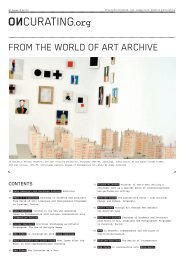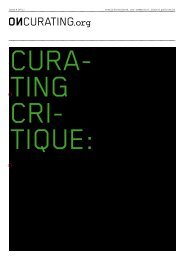You also want an ePaper? Increase the reach of your titles
YUMPU automatically turns print PDFs into web optimized ePapers that Google loves.
056 Issue # 11/11 : PublIc Issues<br />
Authorship<br />
Derya: Using Hirschhorn <strong>as</strong> an example for the concept of<br />
authorship, Bishop argues that Hirschhorn's decision not<br />
to abandon artistic authorship is a correct move. I think<br />
Bishop does not really discuss the issue of authorship<br />
in a way that questions it. What I find appealing in<br />
Oda Projesi's works is exactly a dimension that is missing<br />
in Bishop: namely, the problematisation of authorship.<br />
A complete abandonment of authorship is perhaps impossible<br />
for artists today. Yet raising the subject for discussion<br />
is quite meaningful. I would say that Oda Projesi pro-<br />
blematises authorship in two different senses of the term:<br />
artistic authorship and spatial authorship. For me, the<br />
central problem is not about who holds authorship, or<br />
whether it is transferred (e<strong>as</strong>ily and heroically) from the<br />
artists to the participants (or from the architect/city<br />
planner to the neighborhood community) or not – <strong>as</strong> exempli-<br />
fied in Bishop's argumentation. The main issue is conceiving<br />
and dissecting authorship itself <strong>as</strong> a problem.<br />
When it comes to spatial authorship, it becomes even more<br />
difficult, since the knowledge of architecture, urbanism,<br />
and design is taken <strong>as</strong> a given and its authority and<br />
dominance are usually not challenged. This dominant expert<br />
knowledge and its professional ideology do not allow any<br />
dispute about who holds the authorship of space. I would<br />
say, here one also needs to think of the concepts of<br />
autonomy and authorship together. Authorship involves an<br />
authorial position and almost implies some sort of autho-<br />
rity. Is it possible to hold authorship and be autonomous<br />
at the same time? Perhaps there is a need to reflect upon<br />
the concept of autonomy from the scratch. These questions<br />
remind me of Michael Hardt and Antonio Negri's work, the<br />
Zapatist<strong>as</strong>, and John Holloway's change the World without<br />
Taking Power. Perhaps there is a need to conceive autonomy<br />
not <strong>as</strong> the autonomy of the individual but <strong>as</strong> autonomous<br />
sites emerging at the intersections of singularities. Can<br />
we think of autonomy in this sense <strong>as</strong> a concept challenging<br />
authorship?<br />
Özge: The real issue is to generate states of autonomy in<br />
contexts formed through authorship. Only at this point can<br />
autonomy perhaps equalize anonymity and authorship. Yes,<br />
Oda Projesi is a signature, and I think there is room for<br />
autonomy in the spheres it creates <strong>as</strong> long <strong>as</strong> it main-<br />
tains open-endedness in its projects. I guess you are bring-<br />
ing up the issue of rethinking this spatially when you<br />
talk about the intersection points of singularities?<br />
Derya: Yes, I mean a rethinking of authorship in spatial<br />
terms.<br />
Özge: This is also an issue that is bound to context. For<br />
instance, Hirschhorn produces his work <strong>as</strong> an artist in<br />
the context of contemporary art. He pays the participants<br />
from the neighbourhood and <strong>as</strong> an artist he himself is<br />
also a remunerated part of the chain. This is also what<br />
distinguishes the early ph<strong>as</strong>e of Oda Projesi: if there is<br />
no public funding for contemporary art in Turkey, we told<br />
ourselves that we can then develop alternative strategies.<br />
As Hüseyin Alptekin once said, "complaining does not<br />
help." I think it is important to be aware of these kinds<br />
of institutional conditions while discussing the works<br />
of artists operating in these kinds of art systems in a<br />
European context. There the artist is paid for criticising<br />
the state; and this is a by-product of compensation poli-<br />
ies in Europe. Artists oppose the state with funds from<br />
the state; that is, and I am exaggerating of course, the<br />
state is buying self-criticism.<br />
Additionally, the lived ex-<br />
periences have to be taken<br />
into consideration. Relation-<br />
ships and art works in a way<br />
lose their lived quality when<br />
they are discussed according<br />
to theories. In this sense,<br />
artistic and everyday expe-<br />
riences are not shared to<br />
a sufficient extent. For in-<br />
stance, the ethical, aesthe-<br />
tic, and political dimensions<br />
of Hirschhorn's work are<br />
discussed intensively, but <strong>as</strong><br />
someone coming from the Oda<br />
Projesi experience, I am<br />
more curious about the back-<br />
ground events of that par-<br />
ticular work: what kind of<br />
experiences did the artist<br />
make during the project?<br />
What kind of interventions,<br />
changes, or exchanges did<br />
the work produce within the<br />
lives of its contributors?<br />
There is an instance of<br />
having contact with a com-<br />
munity, and therefore it<br />
cannot be perceived <strong>as</strong> a<br />
one-dimensional work and it<br />
cannot be read solely through<br />
the context of art. We made<br />
a similar mistake in our work<br />
Ada in that we could not<br />
reflect sufficiently on the<br />
details of our collaborative<br />
experience with Mustafa<br />
Tetik. 1<br />
Günes¸: I want to go back to<br />
the question of "what kind<br />
of interventions, changes, or<br />
exchanges the work produces<br />
within the lives of its<br />
contributors". Each project<br />
brings me a sense of ex-<br />
citement and unforeseeability.<br />
Then come moments<br />
of exchange. When the project<br />
comes to its end, what re-<br />
mains are relations that<br />
are produced during these ex-<br />
changes. In several instan-<br />
ces, we realized that we<br />
could not fully manage to<br />
share the relations that had<br />
emerged during the project.<br />
Intervention sounds to me to<br />
be an excessively sharp con-<br />
cept. I would say that Oda<br />
Projesi does not intend to<br />
intervene but it imagines an<br />
exchange triggered by the<br />
sense of being displaced in<br />
the places and positions it<br />
occupies, and by a corres-<br />
ponding potential transfor-<br />
mation. The question is what<br />
kind of things can you<br />
1<br />
Ada w<strong>as</strong> Oda<br />
Projesi's contribu-<br />
tion to the 8th<br />
Istanbul Biennial.<br />
As part of this<br />
contribution,<br />
a gecekondu called<br />
"Mustafa Tetik<br />
Model" w<strong>as</strong> built on<br />
the premises of<br />
the Biennial venue<br />
Antrepo by Mustafa<br />
Tetik and his<br />
friends, who were<br />
experienced gece-<br />
kondu m<strong>as</strong>ter-<br />
builders. The build-<br />
ing process and the<br />
accompanying dis-<br />
cussions were video-<br />
taped but this<br />
footage w<strong>as</strong> not used<br />
later in the pre-<br />
sentation of the<br />
work. The gecekondu<br />
w<strong>as</strong> accompanied<br />
by Annex, a newspaper<br />
composed of texts<br />
discussing urban<br />
issues by way of the<br />
idea of the gece-<br />
kondu. Annex w<strong>as</strong><br />
designed by Oda Pro-<br />
jesi and distri-<br />
buted free of charge<br />
during the Biennial.


![Download as PDF [10.6 MB]](https://img.yumpu.com/4266533/56/500x640/download-as-pdf-106-mb.jpg)

